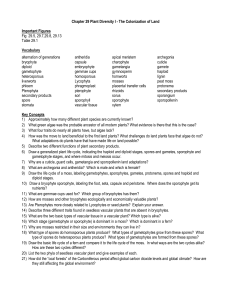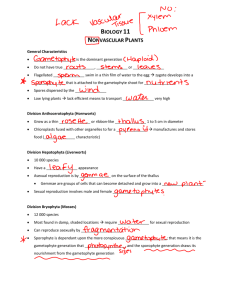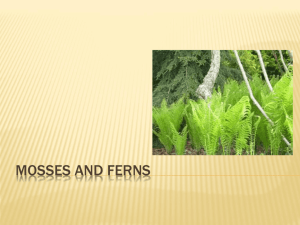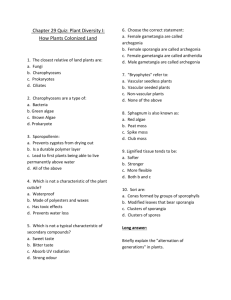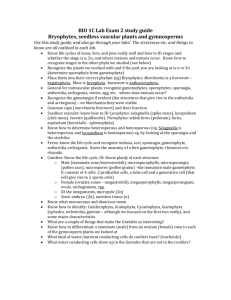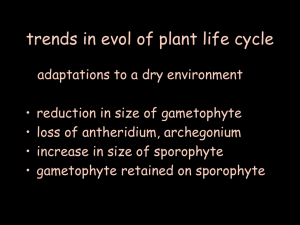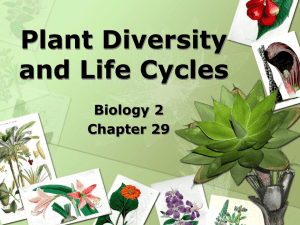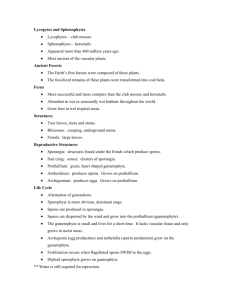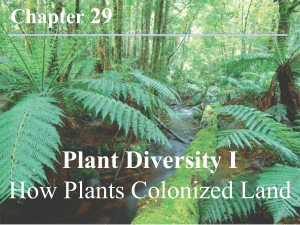Moss
advertisement
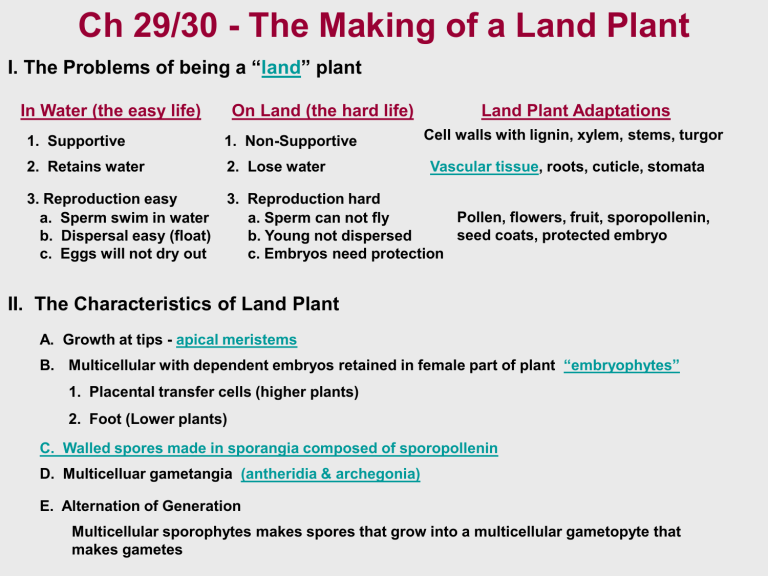
Ch 29/30 - The Making of a Land Plant I. The Problems of being a “land” plant In Water (the easy life) On Land (the hard life) Land Plant Adaptations Cell walls with lignin, xylem, stems, turgor 1. Supportive 1. Non-Supportive 2. Retains water 2. Lose water 3. Reproduction easy a. Sperm swim in water b. Dispersal easy (float) c. Eggs will not dry out 3. Reproduction hard Pollen, flowers, fruit, sporopollenin, a. Sperm can not fly seed coats, protected embryo b. Young not dispersed c. Embryos need protection Vascular tissue, roots, cuticle, stomata II. The Characteristics of Land Plant A. Growth at tips - apical meristems B. Multicellular with dependent embryos retained in female part of plant “embryophytes” 1. Placental transfer cells (higher plants) 2. Foot (Lower plants) C. Walled spores made in sporangia composed of sporopollenin D. Multicelluar gametangia (antheridia & archegonia) E. Alternation of Generation Multicellular sporophytes makes spores that grow into a multicellular gametopyte that makes gametes Highlights of Plant Evolution ) (charophytes BRYOPHYTES LYCOPHYTES MONILOPHYTES GYMNO & ANGIOSPERMS Structures Alternation of Generation Zygote Mitosis Gametes Multicellular Spores Zygote (2n) Gametophyte Sporophyte Sporophyte (2n) Ploidy Meiosis Diploid (2n) Fertilization Haploid (n) Spores (n) Gametes (n) (n) Process Mitosis Multicellular Mitosis Gametophyte (n) Meiosis Fertilization Slide 14 Mitosis Protected Embryos of the “Embryophytes” Protective Coat Embryo of a seed Embryo of a liverwort Foot Placental transfer cells Slide 1 Vascular Tissue Xylem and Phloem in a vascular bundle Stem Slide 1 Plant Clade Relationships Slide 1 The Bryophytes Thallose Liverwort Hornwort Leafy Liverwort Moss Slide 2 Apical Meristem Tissue Leaf Bud Root Tip Slide 1 Phylum Lycophyta Club “Moss” Spore producing strobuli Lycopodium Slide 2 Leaf Evolution Non-Vascular ‘Scale” Vascular Microphyll All other vascular plants Dichotomous branching Scales Tissues fill in branching Microphylls LYCOPHYTES Branching Megaphylls Phylum Monilophytes - The Ferns Phylum Monilophyte - The Horsetails Spore producing strobuli Equisetum “Scouring rushes” Phylum Monilophyte - The Whisk Ferns Sporangia Dichotomous Branching Slide 2 Relationships of Sporophytes and Gametophytes Moss Fern Flowering Plant Slide 2 Types of Gymnosperms Juniper Cycad Ginkgo Sequoia Bristlecone pine Fir Cypress Yew Slide 2 Types of Angiosperms SLIDE 2 Life Cycle of a Flowering Plant Slide 2 Moss Antheridia Moss Archegonia Antheridia Egg Cell Archegonia Sperm Cells Slide 1 Fern Gametophyte with Developing Sporophyte Archegonium Antheridium Rhizoids (Why are they called “rhizoids” and not roots) Slide 3 Lycopodium Gametophyte Slide 3 Horsetail Gametophtye Slide 3 Whisk Fern Gametophtye Why is it brown and not green? Slide 3 What is the difference between a spore and a seed? Spores Seed 1. Unicellular 1. Multicellular 2. Haploid 2. Diploid 3. Asexual reproduction 3. Sexual reproduction 4. First cell of gametophyte 4. Part of the Sporophyte generation 5. Formed by meiosis (usually) 5. Formed by fertilization after mitosis Slide 1 Spores and Sporopollenin Slide 1
